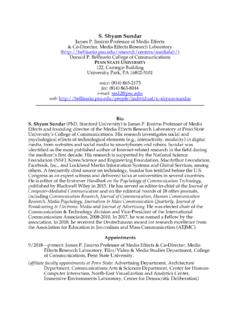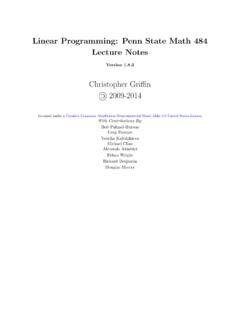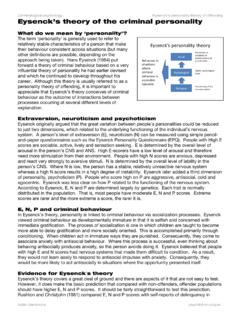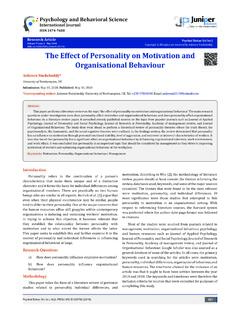Transcription of TRAIT AND BEHAVIORAL THEORIES OF LEADERSHIP: AN ...
1 PERSONNEL PSYCHOLOGY2011, 64, 7 52 TRAIT AND BEHAVIORAL THEORIESOF LEADERSHIP: AN INTEGRATION ANDMETA-ANALYTIC TEST OF THEIR RELATIVE VALIDITYD. SCOTT DERUES tephen M. Ross School of BusinessUniversity of MichiganJENNIFER D. Carey School of BusinessArizona State UniversityNED WELLMANS tephen M. Ross School of BusinessUniversity of MichiganSTEPHEN E. HUMPHREYS meal College of BusinessThe Pennsylvania State UniversityThe leadership literature suffers from a lack of theoretical integra-tion (Avolio, 2007,American Psychologist,62, 25 33). This arti-cle addresses that lack of integration by developing an integrativetrait- BEHAVIORAL model of leadership effectiveness and then exam-ining the relative validity of leader traits (gender, intelligence, personality ) and behaviors (transformational-transactional, initiat-ing structure-consideration) across 4 leadership effectiveness crite-ria (leader effectiveness, group performance, follower job satisfac-tion, satisfaction with leader).
2 Combined, leader traits and behaviorsexplain a minimum of 31% of the variance in leadership effectivenesscriteria. Leader behaviors tend to explain more variance in leadershipeffectiveness than leader traits, but results indicate that an integrativemodel where leader behaviors mediate the relationship between leadertraits and effectiveness is is one of the most discussed and debated topics in thesocial sciences (Avolio, Sosik, Jung, & Berson, 2003; Bass, 1990;Bennis, 2007). Research on leadership began with a search for herita-ble attributes that differentiated leaders from nonleaders and explainedindividuals effectiveness as leaders (Galton & Eysenck, 1869). In effect,this early research was the beginning of the TRAIT paradigm of leadership re-search. Subsequent studies have established that individual characteristics,Correspondence and requests for reprints should be addressed to D.
3 Scott DeRue,Assistant Professor of Management and Organizations, Stephen M. Ross School of Busi-ness, University of Michigan, 701 Tappan Street, Ann Arbor, MI 48109; 2011 Wiley Periodicals, PSYCHOLOGY such as demographics, skills and abilities, and personality traits, predictleadership effectiveness ( , Eagly, Karau, & Makhijani, 1995; Judge,Bono, Ilies, & Gerhardt, 2002; Judge, Colbert, & Ilies, 2004; Mumford,Campion, & Morgeson, 2007).Critiques of the leader TRAIT paradigm (Jenkins, 1947; Mann, 1959;Stogdill, 1948) prompted scholars to look beyond leader traits andconsider how leaders behaviors predicted effectiveness. This led toresearch on initiation of structure and consideration (Hemphill &Coons, 1957; Stogdill, 1963), and established the behavior paradigm ofleadership research. The influence of the leader behavior paradigm can beseen across leadership THEORIES , including Fiedler s (1967) contingencymodel, Blake and Mouton s (1964) managerial grid, and the work ontransformational and transactional leadership (the full range model ofleadership; Avolio et al.)
4 , 2003; Bass, 1985; Podsakoff, MacKenzie,Moorman, & Fetter, 1990). Not only did the leader behavior paradigmprovide the basis for new theory, but meta-analytic evidence also suggeststhat leader behaviors are important predictors of leadership effectiveness(Judge & Piccolo, 2004; Judge, Piccolo, & Ilies, 2004).Both leader traits and behaviors have been investigated in scores of re-search studies. Despite the theoretical and applied value of these studies,leadership research is plagued by a lack of integration. In fact, schol-ars dating back to Bennis (1959) and as recently as Avolio (2007) havelamented over the proliferation and lack of integration of leadership theo-ries and constructs. The primary criticism is that leadership scholars createnew THEORIES of leadership without attempting to compare and contrast thevalidity of existing lack of integration in leadership research is evident both withinand across the TRAIT and behavior paradigms, as research within eachparadigm generally focuses on a single TRAIT or BEHAVIORAL perspective.
5 Forexample, within the TRAIT paradigm, Eagly, Johannesen-Schmidt, and vanEngen (2003) provided meta-analytic estimates for gender and leadershipeffectiveness, whereas Judge et al. (2002, 2004) did the same for person-ality and intelligence, respectively. None of these studies controlled for orcompared the effects of different traits, such as gender, personality , andintelligence concurrently. This lack of integration is problematic giventhat many of these studies found similar effect sizes across leader example, Judge et al. (2002) found absolute effect sizes ranging to .24 for personality and leadership effectiveness, whereas Judge et al.(2004) found an effect size of .21 for intelligence. However, because therewas no integration across traits, it remains unclear as to whether these areindependent , research within the leader behavior paradigm often focuseson a single BEHAVIORAL perspective.
6 For example, Judge and Piccolo (2004)D. SCOTT DERUE ET the literature on transformational and transactional leader-ship, and Judge, Piccolo, and Ilies (2004) did the same for initiating struc-ture and consideration. Neither of these studies integrated across leaderbehaviors or considered whether the effects were independent. Yet, ini-tiating structure and transactional leadership both focus on task-orientedleader behaviors, whereas consideration and transformational leadershipboth comprised relational-oriented leader behaviors (Bass & Bass, 2008;Fleishman, 1953). Given the conceptual similarity, it is not surprising thatseparate meta-analyses found similar effect sizes for example, overallvalidities of .41 for consideration and .44 for transformational (Judge &Piccolo, 2004; Judge et al., 2004). Thus, the two leader behavior paradigmsthat have shaped leadership research for decades may not be independent,and even more importantly, it is unclear if one is a better predictor ofleadership article reviews and integrates the literature on leader traits andbehaviors, and takes a first step toward an integrative theory of how leadertraits and behaviors influence leadership effectiveness.
7 To accomplishthis, we follow a three-stage process. First, based on a narrative reviewof the literature, we develop a conceptual model that organizes the cur-rent literature and models how leader traits and behaviors affect leadershipeffectiveness (see Figure 1). Second, we empirically test the relative valid-ity of select leader traits and behaviors using a combination of previouslypublished meta-analytic data and new meta-analyses. Third, we investi-gate an exemplary set of relationships from our conceptual model to seeif leader behaviors are one possible mechanism through which individualtraits influence leadership Leadership EffectivenessBefore presenting our integrative model, we first define the leadershipeffectiveness domain. Scholars often vary in their definition of leadershipeffectiveness (Avolio et al., 2003; Yukl, 2006), which is one reason theliterature is not well integrated.
8 Based on our review of the literature, lead-ership effectiveness criteria can be conceptualized along three dimensions:(a) content, (b) level of analysis, and (c) target of evaluation. As shownin Figure 1, the content of leadership effectiveness can relate to task per-formance ( , individual or group performance), affective and relationalcriteria ( , satisfaction with the leader), or overall judgments of effec-tiveness that encompass both task and relational elements ( , overalleffectiveness of the leader). The level of analysis corresponds to whetherleadership effectiveness is conceptualized at the individual, dyadic, group,or organizational level. For example, some studies conceptualize leader-ship effectiveness as individual-level leader effectiveness, whereas other10 PERSONNEL PSYCHOLOGYL eader Traits & Characteristics Demographics Task Competence Interpersonal Attributes Tas k-oriented Relational-oriented Leader Behaviors Attribution Processes Identification Processes Attributions & Relational Associations Leadership Effectiveness Content Level of Analysis Ta rget of Evaluation Implicit leadership theory Leader prototypes Leader-followerperceived similarity Identification with leader Group identification Change-oriented Initiating structure Contingent reward Management by exception-active Boundary spanning Directive Consideration Empower ment Participative Developing Enabling Servant leadership Transformational Charismatic, inspirational Gender Age Ethnicity Heigh Education.
9 Social status Intelligence Conscientiousness Openness to experience Emotional stability Technical knowledge Leadership self-efficacy Extraversion Agreeableness Communication skills Emotional intelligence Political skills Overall Task ( , performance) Affective/relational ( , follower satisfaction, leader-member exchange) Individual Dyad Group Organization Leader Other ( , follower, group, organization) Passive Leadership Management by exception-passive Laissez-faire Leader Traits & Characteristics Demographics Task Competence Interpersonal Attributes Tas k-oriented Relational-oriented Leader Behaviors Attribution Processes Identification Processes Attributions & Relational Associations Leadership Effectiveness Content Level of Analysis Ta rget of Evaluation Implicit leadership theory Leader prototypes Leader followerperceived similarity Identification with leader Group identification Change-oriented Initiating structure Contingent reward Management by exception-active Boundary spanning Directive Consideration Empower ment Participative Developing Enabling Servant leadership Transformational Charismatic, inspirational Gender Age Ethnicity Height weight Education.
10 Social status Intelligence Conscientiousness Openness to Experience Emotional Stability Technical knowledge Leadership self-efficacy Extraversion Agreeableness Communication skills Emotional intelligence Political skills Overall Task ( , performance) Affective/relational ( , follower satisfaction, leader-member exchange) Individual Dyad Group Organization Leader Other ( , follower, group, organization) Passive Leadership Management by exception-passive Laissez-faire Figure 1:An Integrated Model of Leader Traits, Behaviors, and SCOTT DERUE ET focus on dyadic-level relationships, group-level performance, ororganizational performance (Kaiser, Hogan, & Craig, 2008). Finally, tar-get of evaluation refers to whether the leader is the target of evaluation( , leader effectiveness, satisfaction with leader) or another outcomethat is within the domain of leadership effectiveness but not specific to theleader ( , group performance).














